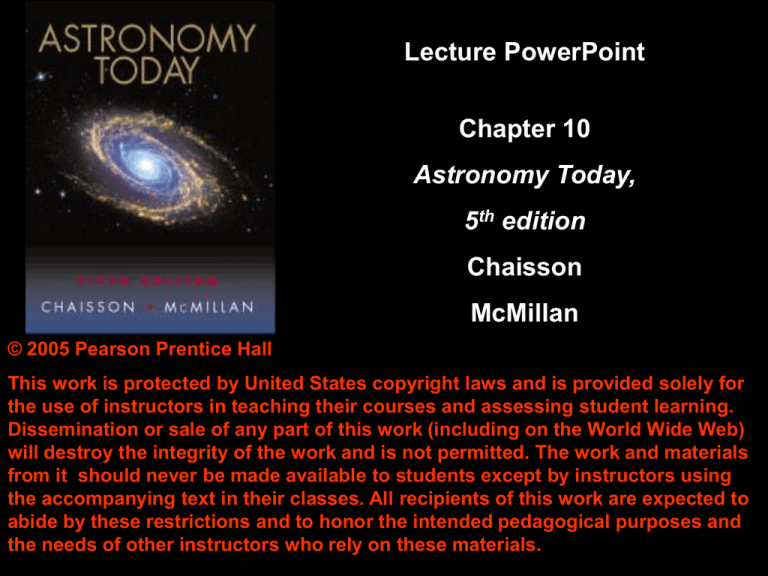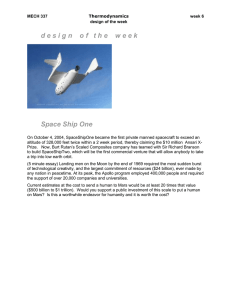
Lecture PowerPoint
Chapter 10
Astronomy Today,
5th edition
Chaisson
McMillan
© 2005 Pearson Prentice Hall
This work is protected by United States copyright laws and is provided solely for
the use of instructors in teaching their courses and assessing student learning.
Dissemination or sale of any part of this work (including on the World Wide Web)
will destroy the integrity of the work and is not permitted. The work and materials
from it should never be made available to students except by instructors using
the accompanying text in their classes. All recipients of this work are expected to
abide by these restrictions and to honor the intended pedagogical purposes and
the needs of other instructors who rely on these materials.
Chapter 10
Mars
Units of Chapter 10
Orbital Properties
Physical Properties
Long-Distance Observations of Mars
The Surface of Mars
The Martian Atmosphere
Life on Mars?
Martian Internal Structure
The Moons of Mars
10.1 Orbital Properties
Mars’s orbit is fairly eccentric – affects amount of
sunlight reaching it
Mars can be either in the direction of the Sun
(conjunction) or not (opposition)
10.2 Physical Properties
Radius: 3400 km
Moons: Deimos, Phobos
Mass: 6.4 × 1023 kg
Density: 3900 kg/m3
Length of Day: 24.6 hours
10.3 Long-Distance Observations of Mars
Can see polar ice caps that grow and shrink
with the seasons:
10.3 Long-Distance Observations of Mars
• Changing polar ice caps are frozen carbon
dioxide; water ice is permanently frozen
• Shifting dust cover makes surface look like
it is changing
• Frequent dust storms, with high winds
10.4 The Surface of Mars
This map shows the main surface features of
Mars. There is no evidence for plate tectonics.
10.4 The Surface of Mars
• Northern hemisphere (left) is rolling volcanic terrain
• Southern hemisphere (right) is heavily cratered highlands;
average altitude 5 km above northern
• Assumption is that northern surface is younger than
southern
• Means that northern hemisphere must have been lowered in
elevation and then flooded with lava
10.4 The Surface of Mars
Major feature:
Tharsis bulge, size of
North America and 10
km above
surroundings
Minimal cratering;
youngest surface on
Mars
10.4 The Surface of Mars
Mars has largest volcano in solar system:
Olympus Mons
• 700 km diameter
at base
• 25 km high
• Caldera is 80 km
in diameter
Three other Martian
volcanoes are only
slightly smaller
10.4 The Surface of Mars
Impact craters less than 5 km across have mostly been
eroded away
Analysis of craters allows estimation of age of surface
Crater on right was made when surface was liquid:
10.4 The Surface of Mars
Recently, gullies have been seen that seem to
indicate the presence of liquid water;
interpretation is still in doubt
10.4 The Surface of Mars
Valles Marineris: huge canyon, created by crustal
forces
Top right: Grand
• 4000 km long
• Maximum 120 km wide, 7 km deep
Canyon on same scale
10.4 The Surface of Mars
Was there running water on Mars?
Runoff channels
resemble those
on Earth.
Left: Mars
Right: Louisiana
10.4 The Surface of Mars
No evidence of connected river
system; features probably due
to flash floods
10.4 The Surface of Mars
Much of northern
hemisphere may have
been ocean:
10.4 The Surface of Mars
Water may now be permafrost under polar ice caps
Left: Southern polar cap,
mostly carbon dioxide
Right: Northern polar cap,
mostly water
Both images
taken during
local summer
10.4 The Surface of Mars
Viking landers both landed in low-latitude
northern plains
Rocky surface, red due to iron content
Viking 1:
10.4 The Surface of Mars
Viking 2:
10.4 The Surface of Mars
Spirit’s landing place was similar to the
Vikings’; this is a 360° panorama:
10.5 The Martian Atmosphere
Martian atmosphere
is mostly carbon
dioxide, and very
thin
Too thin to retain
much heat;
temperature drops
sharply at night
10.5 The Martian Atmosphere
Fog can form in low-lying areas, as sunlight
strikes:
10.5 The Martian Atmosphere
Mars may be victim of runaway greenhouse
effect in the opposite sense of Venus’s:
As water ice froze, Mars became more and more
reflective and its atmosphere thinner and
thinner, freezing more and more water and
eventually carbon dioxide as well.
10.5 The Martian Atmosphere
Life on Mars?
Many searches have been done for life on Mars, but none
has been found.
In 1996, scientists claimed to have found such evidence in
an Antarctic meteoroid from Mars, but this did not hold up.
10.6 Martian Internal Structure
• No seismic studies have been done
• From behavior of crust, it is estimated to
be 100 km thick
• No magnetic field, so core is probably
nonmetallic, nonliquid, or both
10.7 The Moons of Mars
Mars has two tiny moons:
Deimos (left, 16 km × 10 km)
Phobos (right, 28 km × 20 km)
Both probably captured from the asteroid belt
Summary of Chapter 10
• Mars’s orbit is more eccentric than Earth’s
• Rotates in 24.6 hours; axial tilt similar to
Earth’s
• Atmosphere very thin, mostly carbon
dioxide
• Temperature averages 50 K below Earth’s,
but seasons are otherwise similar
• Mars landers have yielded substantial
amounts of data
Summary of Chapter 10, cont.
• Northern and southern hemispheres are very
different
• South is higher and heavily cratered
• North is lower and relatively flat
• Major features: Tharsis bulge, Olympus Mons,
Valles Marineris
• Crater ejecta provide evidence for permafrost
layer under surface (easily liquidized)
• Two small moons, probably captured asteroids





